Sustainable techniques can control pests, protect soil, and keep farm productivity high.
KEY CONCEPT 17.6
Integrated pest management techniques can often effectively control pests while minimizing or eliminating the use of chemical pesticides.
Both of Greg and Raquel’s azolla-control methods—reducing water levels and employing ducks as natural predators—are examples of integrated pest management (IPM), or the use of a variety of methods to help reduce a pest population. The goal of IPM is to successfully control pests while minimizing or eliminating the use of chemical toxins. First, the farmer must examine the life cycle of the pest and the pest’s interactions with the environment to identify the best way to deal with the pest. In general, IPM techniques fall into four categories: cultural control, biological control, mechanical control, and chemical control.
integrated pest management (IPM)
The use of a variety of methods to control a pest population, with the goal of minimizing or eliminating the use of chemical toxins.
In sustainable agriculture, farmers use a combination of cultural, mechanical, and biological controls to deal with pest problems, and they resort to using chemicals only if these methods don’t adequately deter the pests. If a pesticide is going to be used, the preference is for natural, biodegradable chemicals that are toxic only to a limited group of organisms. For example, pyrethrum, a compound naturally produced by a flower in the chrysanthemum family, is directly toxic to insects but not to mammals; it is certified for organic agriculture because it is naturally produced (not a synthetic human creation) and because it breaks down quickly and does not linger in the environment. However, while it does kill pest insects, it is also toxic to good insects like honeybees, so its use is avoided during times of pollination. Synthetic pesticides, like those commonly used in industrial agriculture, are not acceptable for use on certified organic crops but may be part of an IPM plan for conventionally raised crops. INFOGRAPHIC 17.5
Controlling pests is important for our agricultural yields as well as for our health and for the health of our pets. Rather than using harsh methods in an attempt to completely eliminate the pest (which rarely works anyway), a combination of less hazardous methods can often reduce pest numbers to manageable levels.
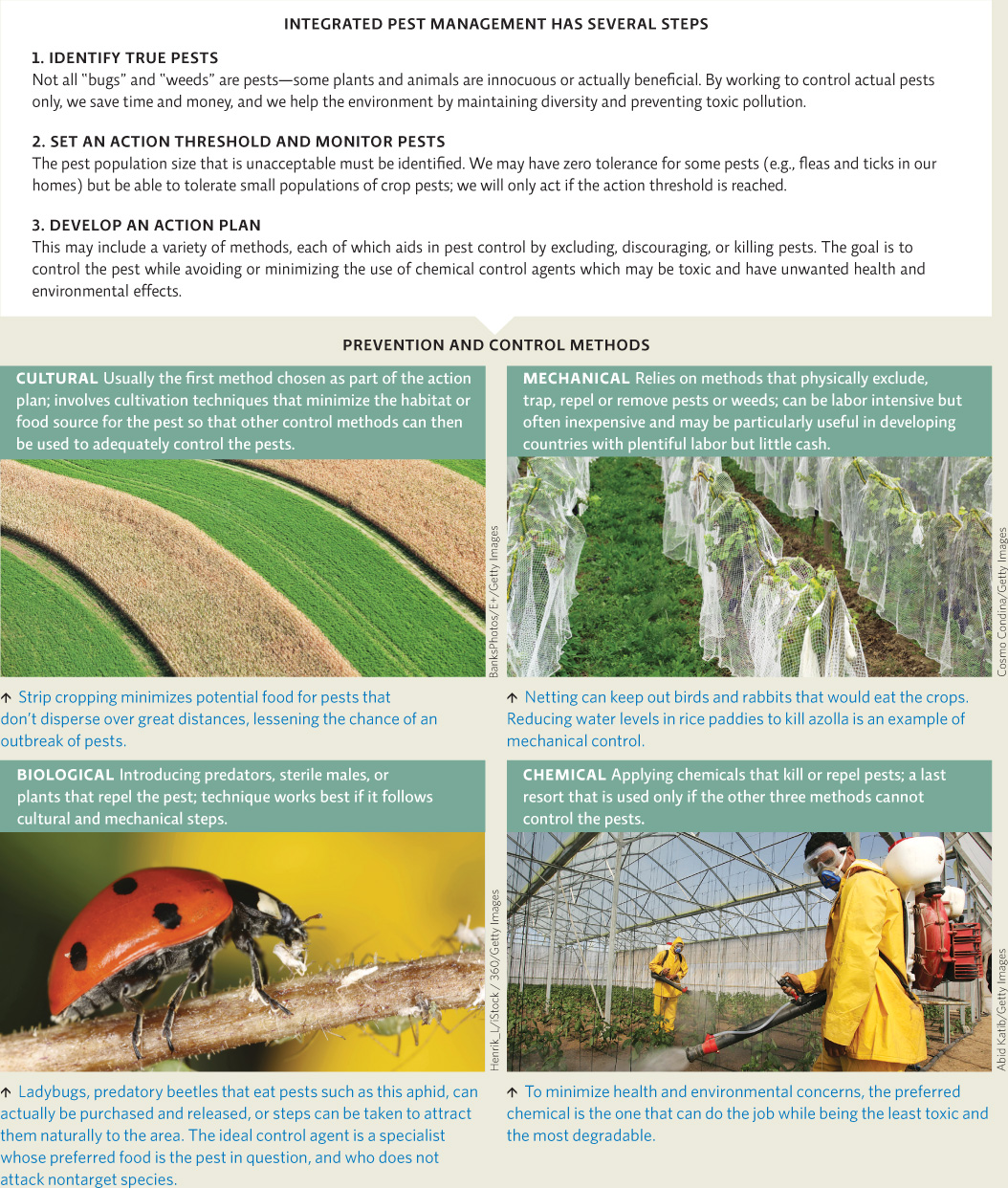
BanksPhotos/E+/Getty Images
Cosmo Condina/Getty Images
Henrik_L/iStock/360/Getty Images
Abid Katib/Getty Images

What pest control methods did the Massas use in their rice fields? Identify each as cultural, biological, mechanical, or chemical.
They used mechanical (changing the water level in the rice fields to control azolla growth) and biological (ducks and fish to eat azolla and other pests).
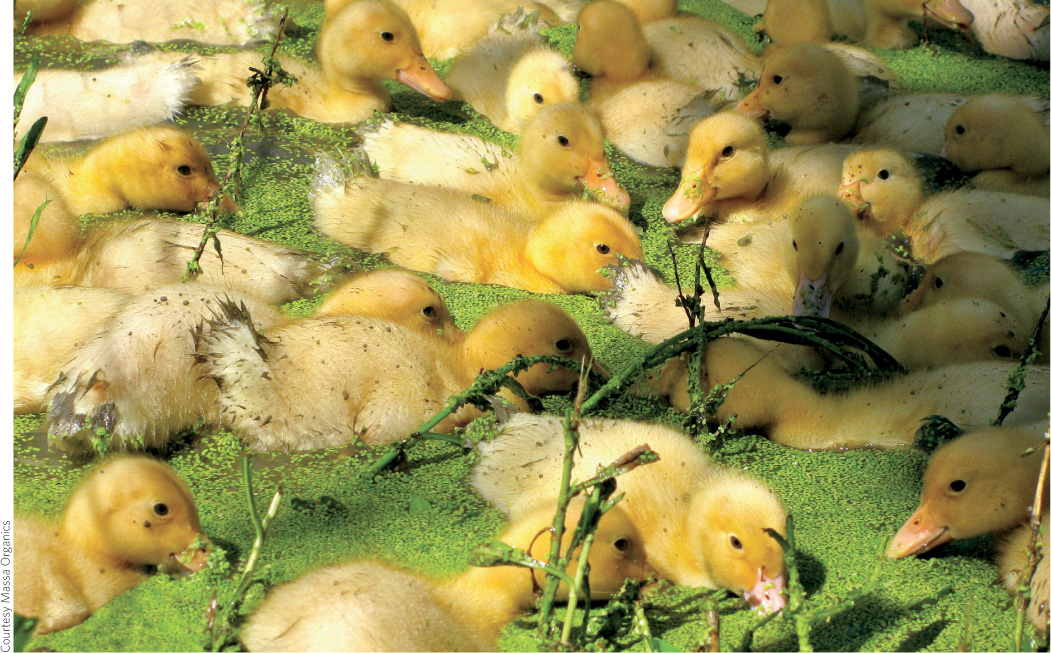
Greg and Raquel were well versed in the problems of modern agriculture. Before settling in California to take over the family farm, they had worked as tropical ecologists in Costa Rica, where they learned about traditional, non-industrial farming methods that help protect the soil and keep productivity high without the use of synthetic fertilizers or pesticides.
KEY CONCEPT 17.7
Sustainable agriculture draws on a variety of traditional farming methods that can protect or improve soil and reduce pest problems. Many of these methods can be used on large and small scales.
Soil is vital to life on Earth; it supports the growth of plants and the animals who feed on those plants. Its formation is very slow (it can take more than 1,000 years to form 2.5 centimeters [1 inch] of topsoil) and depends on myriad soil organisms (see LaunchPad Chapter 27). Modern farming can contribute to a decline in soil fertility and to the direct loss of soil though erosion. However, some traditional (preindustrial) methods can actually help restore or protect soil. For example, methods such as terracing and contour farming can decrease soil erosion on sloped land. Other techniques that protect the soil include reduced-tillage cultivation methods, as well as planting a cover crop in the off-season to prevent exposed soil from washing away. This last approach has the added advantage of helping to restore fertility. Soil fertility can also be enhanced and pests controlled using crop rotation and strip cropping. In addition, systems like Furuno’s that combine animal and plant rearing, return animal waste—a natural fertilizer—to the soil. INFOGRAPHIC 17.6
terracing
The process of leveling land into steps on steep slopes; reduces soil erosion and runoff down the hillside.
contour farming
Farming on hilly land in rows that are planted along the slope, following the lay of the land, rather than oriented downhill.
reduced-tillage cultivation
Planting crops in soil that is minimally disturbed and that retains some plant residue from the previous planting.
cover crop
A crop planted in the off-season to help prevent soil erosion and to return nutrients to the soil.
crop rotation
Planting different crops on a given plot of land every few years to maintain soil fertility and reduce pest outbreaks.
strip cropping
Alternating different crops in adjacent strips, several rows wide; helps keep pest populations low.
Many traditional methods are useful for sustainable agriculture because they focus on protecting the soil, the heart of successful farming.
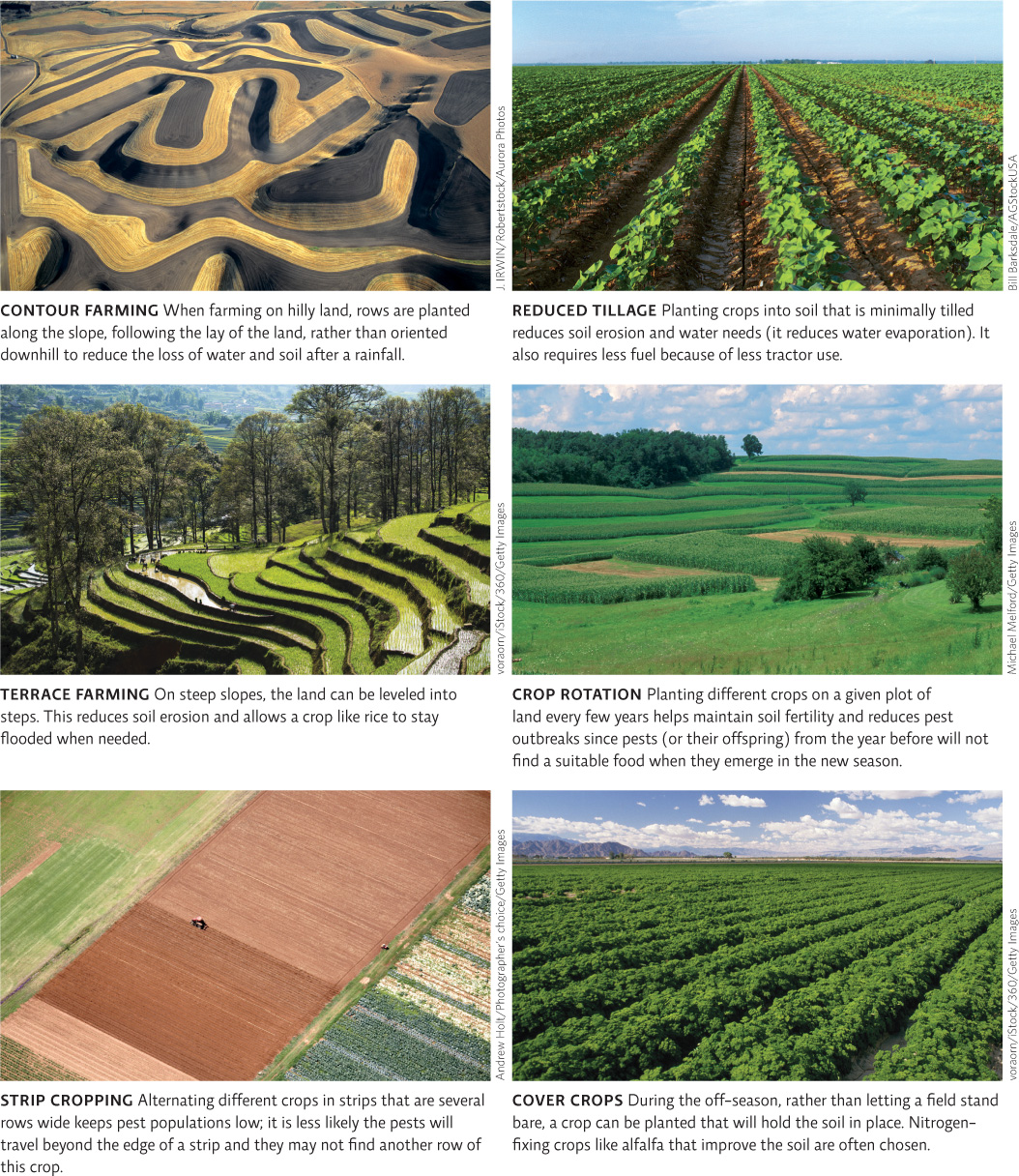
J. IRWIN/Robertstock/Aurora Photos
Bill Barksdale/AGStockUSA
voraorn/iStock/360/Getty Images
Michael Melford/Getty Images
Andrew Holt/Photographer’s choice/Getty Images
voraorn/iStock/360/Getty Images

Which of these sustainable soil practices help reduce soil erosion, which help improve soil fertility, and which help reduce pest outbreaks?
Contour farming, terrace farming, reduced tillage, and cover drops all reduce soil erosion; Crop rotation, strip cropping and cover crops improve soil fertility; Crop rotation and strip cropping help reduce pest outbreaks.
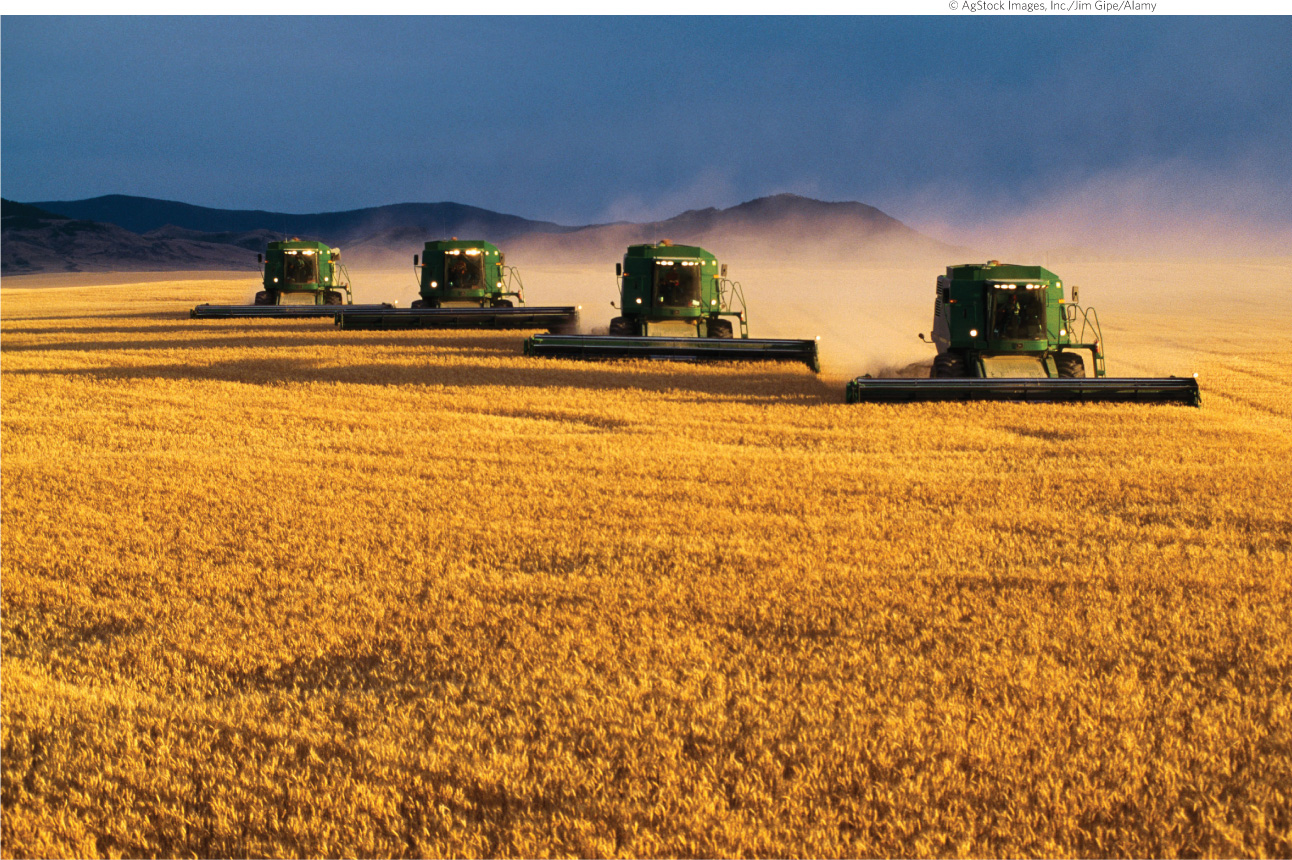
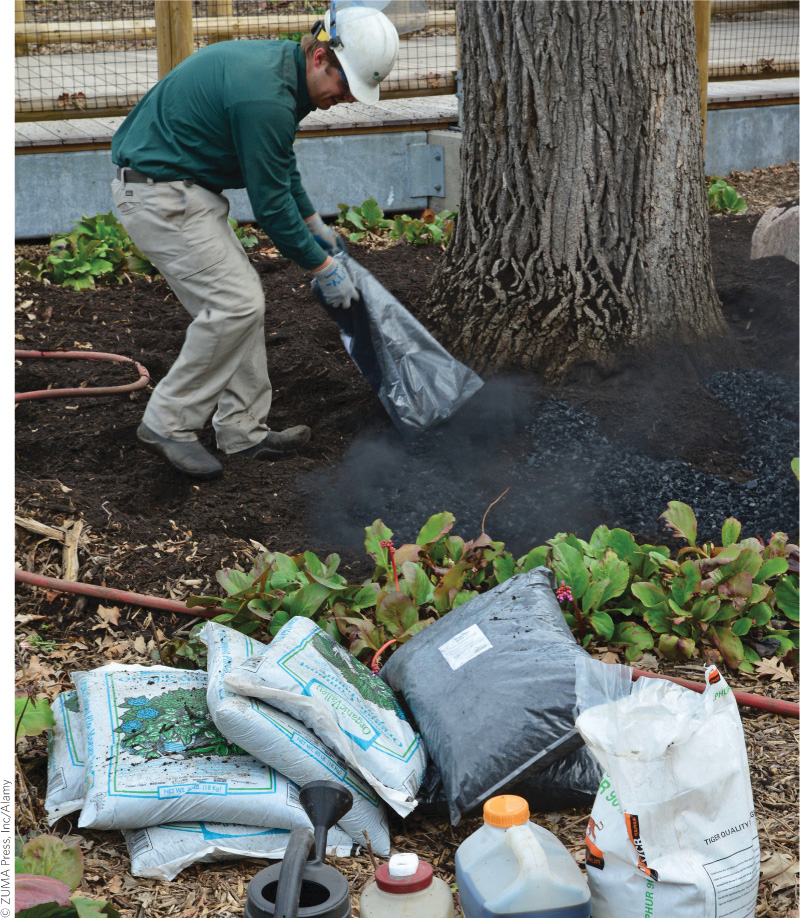
For millennia, humans have employed methods to amend soil to improve its fertility. The addition of fertilizers (natural or synthetic), organic matter (to loosen compacted soil), and substances such as lime (to alter the pH of the soil) are all soil amendments that can address soil problems. But recently a traditional soil amendment from the tropics is gaining interest—biochar. Biochar is a form of charcoal produced when organic matter (usually agricultural waste) is partially burned. The use of biochar over thousands of years helped create the fertile terra preta soils in the Amazon basin, where thin, poor, acidic soils predominate. Not only does biochar provide nutrients to poor soils, it also helps the soil store carbon (it does not decompose readily so “holds onto” much of its carbon), impeding its release into the atmosphere and reducing its contribution to climate change.
biochar
A form of charcoal that is produced when organic matter is partially burned and that can be used to improve soil quality.